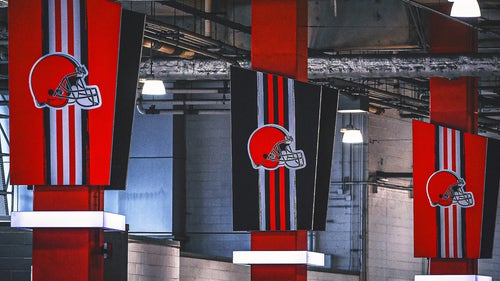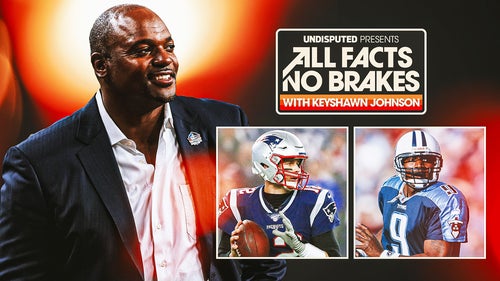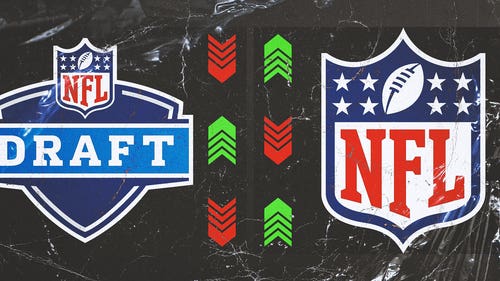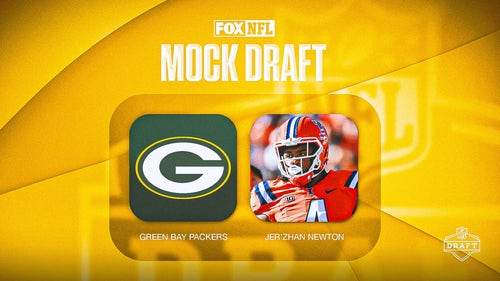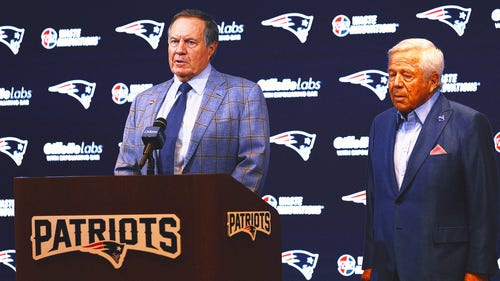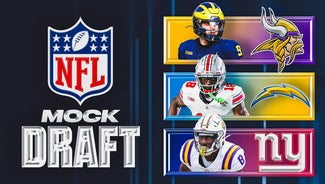
Tight ends bigger part of NFL offenses
Fueled by the performances of then-rookies Rob Gronkowski and Aaron Hernandez, the New England tight end contingent combined for 18 touchdown catches in 2010. That was actually one more scoring reception than the Patriots got from the position the three previous years combined.
Last season, the trio of Gronkowski, Hernandez and the now-departed Alge Crumpler posted an aggregate 93 receptions for 1,161 yards. For the 2007-09 campaigns, by comparison, the Pats' tight end groups averaged only 40.0 catches and 438.7 yards.
The resurrection of the nearly extinct tight end spot in New England largely began with the selection of Gronkowski in the second round of the '10 draft, and the follow-up choice of Hernandez in the third round. And then it continued with the conscious decision by the New England offensive staff to retool a passing-game design that had become increasingly reliant on its wide-receiver corps.
"I think we knew we had to get better (at tight end)," Patriots coach Bill Belichick said this spring. "I don't know that what we did was necessarily revolutionary or anything . . . but it was something that we just wanted to do."
Actually, despite the emphasis in New England on the tight end position since 2010, the Pats weren't exactly front-runners for a change in reconfiguring and remaking the spot. In truth, the Patriots offense was essentially catching up to an NFL tight end sea change in which the franchise had previously been mostly treading water.
Over the past several seasons, the tight end position in the NFL has inexorably evolved away from the standard that once served as the model. Nearly 40 years ago, the Buffalo Bills took a former All-America tackle from Michigan, Paul Seymour, and switched him to tight end; such conversions were fairly commonplace at the time. There were not nearly as many tackle-to-tight end metamorphoses in the four decades since, but even until four or five years ago, league scouts were attempting to locate hybrid types, players who could provide an in-line blocking presence combined with the ability to catch the football.
The bird dogs are still on the hunt, but given the elements that have altered the game so much, they've got to turn over a veritable moonscape's worth of rocks to unearth one. The old-school tight ends are in decreasing numbers these days. The trend is toward tight ends who can run routes more than root out linebackers and defensive ends.
Traditional in-line tight ends like Pittsburgh's Heath Miller or Jeremy Shockey of Carolina are a dwindling breed. Gone are the days of the men who once defined the position, like the recently deceased John Mackey or Mike Ditka.
"We're looking for Superman, the guy who can go down the middle of the field (as a receiver) and also block, and he doesn't exist," former NFL general manager Charlie Casserly, now a CBS pregame analyst, told the Pittsburgh Post-Gazette last week.
And New York Giants general manager Jerry Reese told the Post-Gazette: "Those guys aren't out there."
But better receiving tight ends such as Dallas Clark (Indianapolis), Jermichael Finley (Green Bay), Dustin Keller (New York Jets), Kellen Winslow (Tampa Bay), Vernon Davis (San Francisco), Owen Daniels (Houston), Brandon Pettigrew (Detroit), Chris Cooley (Washington), Brent Celek (Philadelphia), Jermaine Gresham (Cincinnati), Visanthe Shiancoe (Minnesota), and others, are available.
And league offenses are taking big-time advantage of them. Tight ends even as pass catchers have progressed to the point where they are effective all over the field, not just in the red zone.
League tight ends are a little shy of the pace set in 2010, when players at the position established records for catches (2,256), yards (24,969) and scores (190), but they are already ringing up big numbers at this early point of the 2011 season. Eighteen tight ends are on pace for 50 or more receptions and five are on pace for at least 75 catches, both of which would be records. Five tight ends are averaging 14.5 yards per catch or more, and Gronkowski and Shockey are over 16 yards per catch.
That used to be unheard-of territory for tight ends, who personified the handle of short- to intermediate-range receiver.
Finding a player who fits the versatility requirements for the way the tight end position was principally envisioned a decade or so ago isn't quite as difficult as, say, stumbling onto Yeti during a camping trip. But it's close. It's an understatement to suggest that the demand far eclipses the current supply.
And so, it seems, the league has accordingly adjusted to the dearth of old-style tight end candidates. Most of the new-age tight ends still exceed 250 pounds — only 19 of the 98 tight ends (not including deep-snappers) listed on active league rosters on Thursday night weighed in at less than that — but the body type has definitely changed. And while the preferred skill-set remains the same, the all-around responsibilities are different now.
The average weight of tight ends presently on NFL rosters, 255.8 pounds, isn't all that different from what is was for 2001. Still, the position has changed a lot, noted a guy who has been around long enough to witness the overhaul firsthand.
"You still have to block, and I take a lot of pride in that part of the game, but it's not at the same kind of (requirement) level," said Atlanta tight end Tony Gonzalez, a 15th-year veteran and 11-time Pro Bowl performer who figures to be enshrined in the Hall of Fame someday. "The so-called 'complete' tight end is what everyone wants to have, but that kind of guy is sort of disappearing now."
Despite being the league's all-time leader among tight ends in receptions (1,090), receiving yards (12,692) and touchdowns (92), Gonzalez, 35, is more a throwback than most people consider. Although Gonzalez has registered 12 years of 60 or more catches and is on pace in 2011 for a sixth year with 80-plus receptions, he spent much of his career playing in-line. He also spent the lion's share of his tenure as the lone tight end on the field for the Kansas City Chiefs and Falcons.
These days, clubs are deploying multiple-tight ends sets more than ever — there has been a long-held theory by some observers that the two-tight end look is the ultimate formation for balancing the field, but some coordinators, like Pittsburgh's Bruce Arians, use three tight ends at a time — and in an increasing variety of places.
One can see the growth in the use of the tight end position merely in the number on rosters at the current time. The NFL basically averages three tight ends per club, and eight franchises have more than that; the Packers have a league-high five. Just seven years ago, virtually every team had two tight ends on the roster.
The versatility of the tight end position has taken on new meaning. While many clubs don't count on the tight end as an in-line blocker anymore, teams have taken to using them more as blockers in the wedge on kickoff returns because of rules that limit the number of wedge blockers.
"There's still some versatility there you can use, but not in the way you used to," said Falcons special-teams coordinator Keith Armstrong.
The disappearance of the traditional fullback position for many teams has meant the use of an H-back tight end. More teams utilize a pair of in-line tight ends. And clubs are "flexing" their tight ends, aligning them in the slot, using them as third or fourth receivers in more formations. The lumbering tight end hasn't been replaced so much by a leaner version but clearly by a quicker model, one who certainly is much more a receiver than blocker and is far more athletic. The duality required of the position isn't the same as the old hybrid definition.
"Even just in the (eight) years I've been in the league," said Shiancoe, "the position has undergone a big change."
For the 2010 season, 11 teams used at least two tight ends on the field at the same time on more than 40 percent of their offensive snaps, and the feeling is that quota will increase this year. A few clubs in the first four weeks of the season have played games in which they employed multiple-tight ends set nearly 75 percent of the time.
Perhaps the current revolution began in earnest when then-San Diego coach Don Coryell, a great passing-game innovator, moved Hall of Fame tight end Kellen Winslow (the elder) away from the tackle to create mismatches against linebackers and safeties. "But just watching (video) of some of the things that he was asked to do, (or) talking to him about it, I'm not sure I could do it," acknowledged the younger Winslow. "Some of it was still old-school stuff."
Hall of Fame tight end and current Baltimore general manager Ozzie Newsome was one of several NFL observers who used to suggest that the most desirable tight end candidates were probably playing power forward on basketball courts. "But we're taking more small forwards now," Newsome said.
The man who replaced Shockey as the starter in New Orleans, second-year pro Jimmy Graham, is a former hoops player at the University of Miami who played only one season for the Hurricanes' football squad. Graham is frequently cited as an example of what the position is morphing into.
Of course, Gonzalez and San Diego's Antonio Gates, who has spent much of his time in the league flexed away from the line of scrimmage and in the slot, are both former college basketball players. While the two veterans have used movement skills inherent to basketball to develop as receivers, they still aren't as quick as many of the new-breed tight ends. And they were still required to do more things, it seems, than tight ends are asked to accomplish in today's game.
"You still have to put your hand on the ground on occasion," said Dallas ninth-year veteran Jason Witten, who has averaged 91.3 catches over the past three seasons. "But you have to be able to move outside and create matchup problems. And you'd better be able to (spilt) the safeties and catch the ball."
Certainly, passing-game designs are trending more toward throwing the ball to the tight end. Coordinators are striving to create advantageous matchups for tight ends, who are typically quicker than linebackers or safeties and often too big and physical to be checked by nickel cornerbacks.
"More and more," said one offensive coordinator, whose team spent a good portion of the lockout this spring developing a more substantial package for its tight end, "you want to have a tight end who can exploit people. And you're seeing teams with more than just one 'receiving' tight end."
Case in point: When Clark, who had averaged 78.3 catches from 2007 to '09 — and who had been Peyton Manning's safety net in Indianapolis — injured a wrist after only six contests in 2010, little-used Jacob Tamme caught 67 passes despite starting just eight games.
"It's a big part of what we do," Tamme said.
There are plenty of reasons for the change in philosophy at tight end, starting with the aforementioned difficulty in finding candidates to fill the hybrid role. But the evolution also has something to do with the prevalence of 3-4 defenses in the NFL — and the need to counter them. A big factor, too, is that fewer traditional tight ends are in the draft now.
"So many (college) teams are playing spread offenses that they don't use the tight end the way we used to define it," said Washington coach Mike Shanahan, who has benefited so far from the development this year of fourth-year veteran Fred Davis to complement Cooley. "The college offenses don't develop those guys. You can't just invent them."
And so the league, instead, has reinvented the position.







































































































































